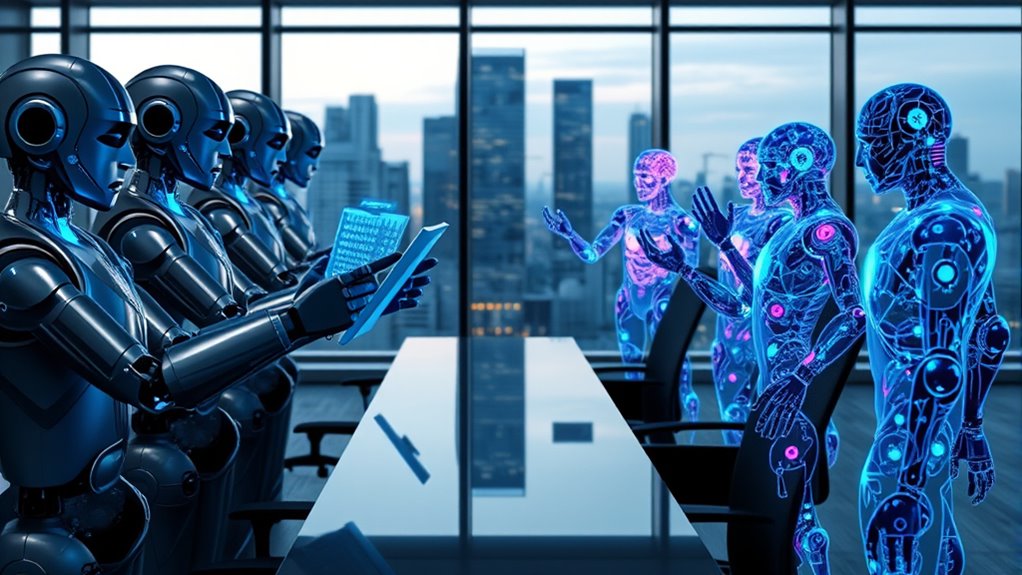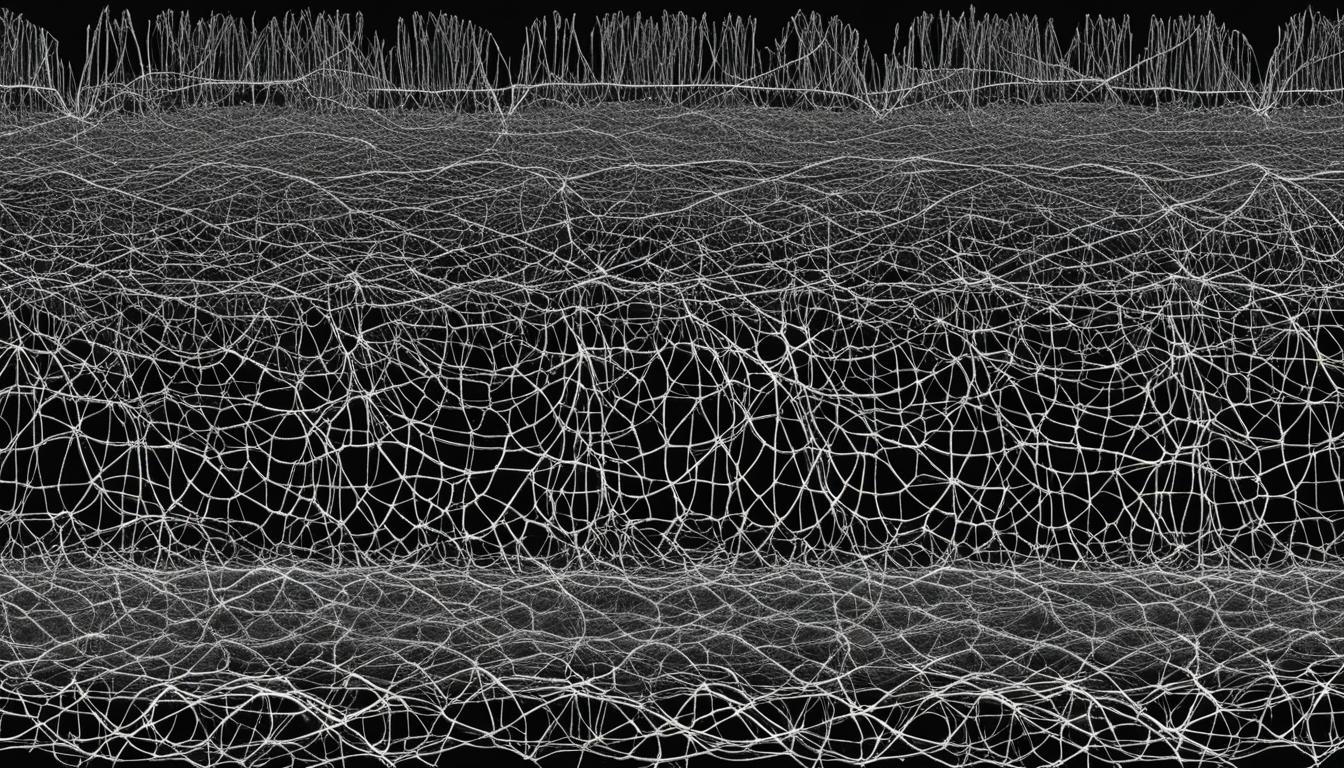Robotic Process Automation (RPA) handles repetitive, rule-based tasks quickly and reliably, making it perfect for straightforward workflows, while generative agents bring adaptability and creativity, enabling complex interactions and decision-making. RPA boosts efficiency with minimal oversight, but generative agents can support more dynamic roles that need innovation. As these technologies evolve, understanding their differences helps you choose the best tool for your organization’s goals. Keep exploring to discover how they will shape the future workplace.
Key Takeaways
- RPA automates repetitive, rule-based tasks efficiently, while generative agents handle complex, creative, and decision-making interactions.
- RPA offers quick, reliable automation with minimal oversight, whereas generative agents require ongoing tuning and ethical monitoring.
- RPA is best suited for simple processes like data entry; generative agents excel in roles involving communication, content creation, and problem-solving.
- Implementing RPA enhances compliance and reduces errors; generative agents raise considerations around bias, transparency, and data privacy.
- The choice depends on organizational goals: efficiency and simplicity versus innovation and adaptive interaction.

Robotic Process Automation (RPA) and generative agents are transforming how businesses handle tasks, but they serve different purposes and operate in distinct ways. When considering AI integration, RPA typically automates repetitive, rule-based processes, freeing up your time for more strategic work. It’s like having a digital worker that follows pre-set instructions to complete tasks such as data entry, invoice processing, or customer onboarding. Generative agents, on the other hand, are designed to create, adapt, and interact more dynamically. They can generate human-like text, images, or responses, making them ideal for tasks requiring conversation, content creation, or complex problem-solving. Understanding these differences helps you decide which technology aligns best with your business needs.
As you explore AI integration, it’s essential to think about ethical considerations. RPA’s straightforward automation reduces human error and enhances compliance, but it can also raise concerns about job displacement. You need to weigh the benefits of increased efficiency against the social impact of automation, ensuring that your deployment aligns with ethical standards and workforce development. Generative agents introduce additional ethical questions, such as data privacy, bias, and transparency. Since they learn from vast datasets, there’s a risk of reinforcing existing biases or generating inappropriate content if not carefully monitored. Additionally, the effectiveness of these systems can be influenced by the color accuracy of the media they produce, which impacts overall output quality. As you implement these systems, you must establish guidelines to prevent misuse and ensure responsible AI use.
The way you approach these technologies also depends on your organization’s goals. RPA is more suitable if your focus is on streamlining simple, repetitive tasks quickly and reliably. Its AI integration is limited to rule-based processes, so it’s less flexible but easier to implement and manage. Generative agents require more sophisticated AI integration, involving training on large datasets and ongoing tuning to maintain accuracy and ethical compliance. They’re better suited for roles involving interaction, creativity, or decision support, but they demand more oversight to handle ethical considerations effectively.
Ultimately, your choice between RPA and generative agents hinges on your specific needs and values. RPA offers efficiency and simplicity, while generative agents provide adaptability and innovation. Both require careful consideration of ethical considerations, particularly around transparency, bias, and impact on your workforce. As AI continues to evolve, staying informed about these differences ensures you leverage the right technology responsibly, avoiding pitfalls and maximizing benefits for your business.
Frequently Asked Questions
How Do RPA and Generative Agents Impact Employee Job Roles?
You’ll find that RPA and generative agents considerably impact your job roles by requiring employee adaptation and skill transformation. As these technologies automate routine tasks, you’ll need to develop new skills, such as managing AI tools or analyzing data. This shift encourages you to focus on strategic, creative, or interpersonal work, ultimately enhancing your value in the office. Embracing change ensures you stay relevant and can thrive alongside evolving automation.
What Are the Cost Differences Between Implementing RPA and Generative Agents?
Imagine a chess game where each move impacts your future—this is like weighing cost differences. When you compare RPA and generative agents, your cost analysis reveals RPA’s lower initial investment requirements, mainly for automation setup. Generative agents, while potentially more costly upfront, can reduce ongoing operational costs. Understanding these investment needs helps you choose the most cost-effective solution aligned with your business goals.
Can RPA and Generative Agents Work Together Seamlessly?
You can definitely get RPA and generative agents to work together, but you’ll face some integration challenges. To guarantee smooth technology synergy, plan carefully to align workflows and data sharing. Using APIs and middleware can help bridge systems, reducing friction. By addressing these challenges proactively, you’ll create a seamless collaboration that boosts efficiency and leverages the strengths of both automation types.
Which Technology Offers Better Scalability for Large Organizations?
You want to know which technology scales better for large organizations. Both options leverage cloud integration and address data privacy, but generative agents often offer more adaptability, handling complex tasks with ease. RPA excels at automation but may struggle with scaling across diverse systems. Ultimately, your choice depends on your organization’s needs—prioritizing flexibility with generative agents or streamlined processes with RPA.
What Are the Potential Security Risks Associated With Each Technology?
You should consider that both technologies pose security risks. With RPA, data privacy issues arise if sensitive data isn’t properly secured, and malware vulnerabilities can be exploited through automation scripts. Generative agents, on the other hand, might expose data privacy if they access confidential information, and they could be targeted by malware designed to manipulate or corrupt their outputs. Always implement robust security measures to mitigate these risks.
Conclusion
As you consider the future, remember that 70% of organizations are already exploring robotic process automation alongside generative agents. This shift signals a major transformation in how work gets done—streamlining tasks and boosting creativity. Whether you’re automating routine processes or leveraging AI for complex decisions, embracing both technologies can give you a competitive edge. The next office battle isn’t about choosing one; it’s about integrating both to open new levels of productivity.









